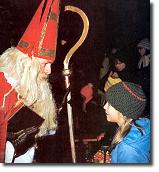Catholic Activity: Celebrating for the Feast of St. Nicholas

The feast of St. Nicholas, bishop, falls on December 6, at the beginning of Advent. This day brings much celebrating, especially in Eastern Europe and Germanic countries such as Germany, Austria, Switzerland and the Netherlands. Italy also celebrates this saint's day.
DIRECTIONS
In a time where Christmas is highly commercialized, families try to keep the focus on what Advent and Christmas is all about. Advent is preparing for Christ's birth, both internally and externally. To shift the focus of the materialistic or "give me" common at Christmas, try giving stocking gifts on December 6 instead of Christmas Day. Shoes can be left outside the bedroom door or on the hearth, or stockings are hung by the fire on December 5th evening. St. Nicholas (instead of Santa Claus) comes by to brings cookies or gifts in the shoes or stockings.
In Germanic countries, St. Nicholas is accompanied by Krampus, an evil spirit or little devil, usually dressed in fur or black with a long tail, and carries a rattling chain, birch branches and a big black bag. In Holland Sinterklass or Sinterklaus leaves from Spain on a boat, accompanied by Black Peter (Piet), his Moor servant. Peter wears animal skins or the traditional medieval Moorish colorful clothing.
December 5, St. Nicholas Eve, is known in some rural areas of Austria as "Krampus Day." Children and adults go to the village square to throw snowballs and try to chase off Krampus. Other Krampuses lie in wait, rattling their chains and threatening to carry off naughty children in their black bags, or to punish them with their birch branches. All this is done in fun; Krampus' main purpose is remind the children to be good.
In most Germanic countries, St. Nicholas comes on December 5. Children leave their shoes on the windowsill or outside their bedroom door, and St. Nicholas rewards the children who have been good all year by filling up their shoes with goodies, such as nuts, fruits and sweets. Sometimes he comes on December 6, his actual feast day.
In Austria, the good saint will appear in his flowing robes and bishop's mitre and carrying a bishop's staff. He carries a thick book which has the records the Guardian Angels have been keeping all year — all the good and bad deeds of the world's children. At the appointed time, the whole family is gathered for St. Nicholas' arrival. Krampus accompanies the bishop to scold naughty children. The bishop calls each child of the family forward to give an account of the year, and perhaps to recite their prayers. When Krampus tries to punish the naughty, St. Nicholas drives him away. After each child promises good behavior for the next year, he distributes the treats. Sometimes, in addition to the goodies, he rewards the children with birch branches decorated with candy, just as a reminder that Krampus is around if they should falter.
Whether celebrated on the eve or December 6, this holiday is a great occasion for children and adults. See suggested recipes for this feast day.
Activity Source: Original Text (JGM) by Jennifer Gregory Miller, © Copyright 2003-2025 by Jennifer Gregory Miller






